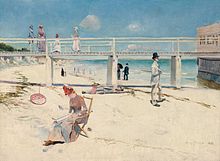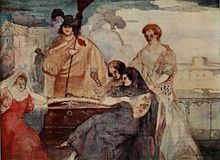- Charles Conder
-
Charles Edward Conder. 
Born October 24, 1868
Tottenham, MiddlesexDied February 9, 1909 (aged 40) Nationality Australian Field Painting Charles Edward Conder (24 October 1868 – 9 February 1909)[1] was an English-born painter, lithographer and designer. He emigrated to Australia and was a key figure in the Heidelberg School, arguably the beginning of a distinctively Australian tradition in Western art.
Contents
Early life
Conder was born in Tottenham, Middlesex, the second son, of six children, of James Conder, civil engineer and Mary Ann Ayres.[2] He spent several years as a young child in India before the death of his mother on 14 May 1873 in Bombay, aged 31 years; he was then sent back to England and attended a number of schools including a boarding school at Eastbourne, which he attended from 1877. He left school at 15, and his very religious, non-artistic father, against Charles's natural artistic inclinations, decided that he should follow in his footsteps as a civil engineer.[3]
In 1884, at the age of 17, he was sent to Sydney, Australia, where he worked for his uncle, a land surveyor for the New South Wales government. However he disliked the work, much preferring to draw the landscape rather than survey it. In 1886, he left the job and became an artist for the "Illustrated Sydney News", where he was in the company of other artists such as Albert Henry Fullwood, Frank Mahoney and Benjamin Edwin Minns. He also attended the painting classes of Alfred James Daplyn and had joined the Art Society of New South Wales.[1][4]
Career
In 1888, Conder moved to Melbourne where he met other Australian artists including Arthur Streeton, and shared a studio with Tom Roberts, whom he had previously met in Sydney. Short of cash, the attractive Conder apparently paid off his landlady by sexual means, catching syphilis in the process, which was to plague the later years of his life. During his two years in Melbourne, Conder worked with the other members of the school and produced a number of famous works, including Under The Southern Sun. This painting clearly shows the burning sunlight and desolation that can be inflicted by an Australian drought.[5]
In Sydney and later Melbourne Conder associated with G. P. Nerli, an itinerant Italian painter and the bearer of new European influences who has been credited with shaping Conder's development. The extent of the influence has been debated, but the fact of it is undeniable. Like Conder, Nerli was a bon-vivant whose appreciation of the 'dam fine' 'Melbourne girls' survives in a letter to a mutual friend, Percy Spence.
Conder was a fun-loving man who painted with an often humorous touch. While staying with Tom Roberts in his famous Grosvenor chambers studio, he painted A holiday at Mentone (1888), which shows men and women at the beach relaxing while clothed from head to foot–the men in suits and hats; the ladies in long, girdled dresses with boots and pretty hats. The man and woman at the front of the painting face away from each other, yet possibly are interested in each other, each watching the other from the corner of their eye. The mood is one of simple elegance and with a relaxed feel, as in the background people are strolling along the beach into the distance. The composition of the painting has possibly been borrowed from a work by Whistler in which a bridge similarly transects the picture. Conder among other painters such as Frederick McCubbin had been directly or indirectly influenced by Whistler.
Europe
Conder left Australia in 1890, and spent the rest of his life in Europe, mainly England, but visiting France on many occasions. His art was better received in England than in Paris. In 1892, Henri de Toulouse-Lautrec painted his portrait, a portrait that now hangs in the National Gallery of Australia. He continued to paint, but his output was severely affected by continual poor health, including paralysis and a bout of delirium tremens. He married a wealthy widow, Stella Maris Belford (née MacAdams) at The British Embassy Paris on 5 December 1901, giving him financial security. His later works are not nearly as well regarded critically as his earlier Australian paintings.
Later life and death
He spent the last year of his life in a sanatorium, and died in Holloway Sanatorium of "general paresis of the insane", in modern terms tertiary syphilis. In death, Conder's work was rated highly by many notable artists, such as Pissarro and Degas.
The Canberra suburb of Conder, established in 1991, was named after him.
See also
Visual arts of Australia
Reference
- ^ a b Ursula Hoff, 'Conder, Charles Edward (1868 - 1909)', Australian Dictionary of Biography, Vol. 3, MUP, 1969, pp 446-447.
- ^ Conder's other surviving siblings were Samuel James and Alice. (Gibson, 1914, p. 23).
- ^ Gibson, pp. 23-25
- ^ Gibson, pp. 26
- ^ Under the southern sun, 1890 (artistsfootsteps.com).
 This article incorporates text from a publication now in the public domain: Chisholm, Hugh, ed (1911). "Conder, Charles". Encyclopædia Britannica (11th ed.). Cambridge University Press.
This article incorporates text from a publication now in the public domain: Chisholm, Hugh, ed (1911). "Conder, Charles". Encyclopædia Britannica (11th ed.). Cambridge University Press.Bibliography
- Galbally, Ann. Charles Conder: the last bohemian, Miegunyah Press: Melbourne University (2002) Catalogue reference and book summary
- Gibson, Frank & Dodgson, Campbell. Charles Conder; his life and work (London: John Lane, 1914).
External links
- Charles Conder online (ArtCyclopedia)
- "Artist's footsteps", source of most material for this article
- Charles Conder on Picture Australia
- Conder collection, National Gallery of Victoria
- An early taste for literature 1888 - Ballarat Fine Art Gallery.
- Review of Conder exhibition ("Nineteenth-century Art Worldwide" on-line magazine)
Categories:- 1868 births
- 1909 deaths
- Australian painters
- People from Tottenham
Wikimedia Foundation. 2010.


